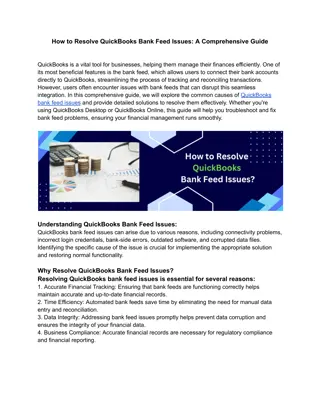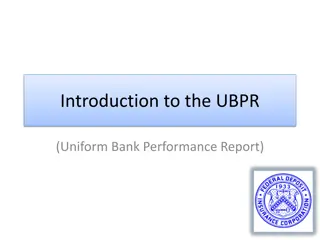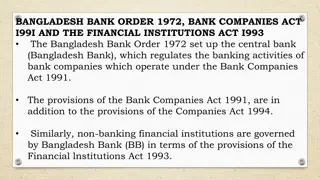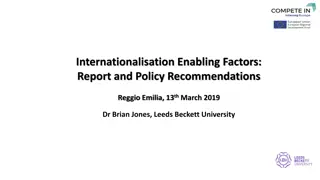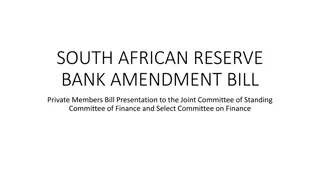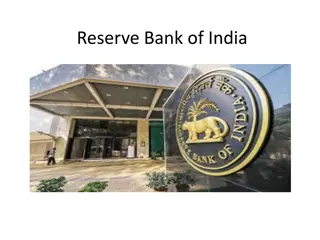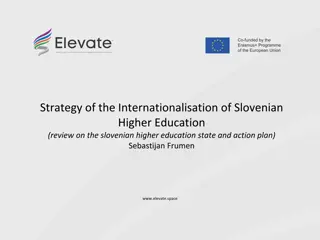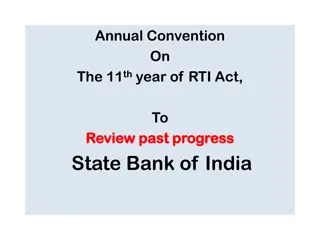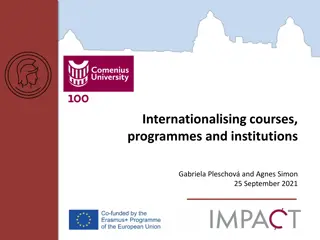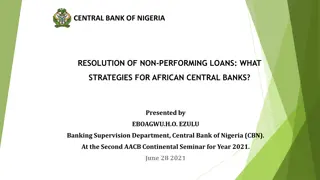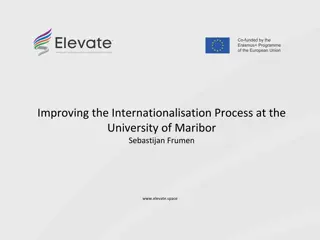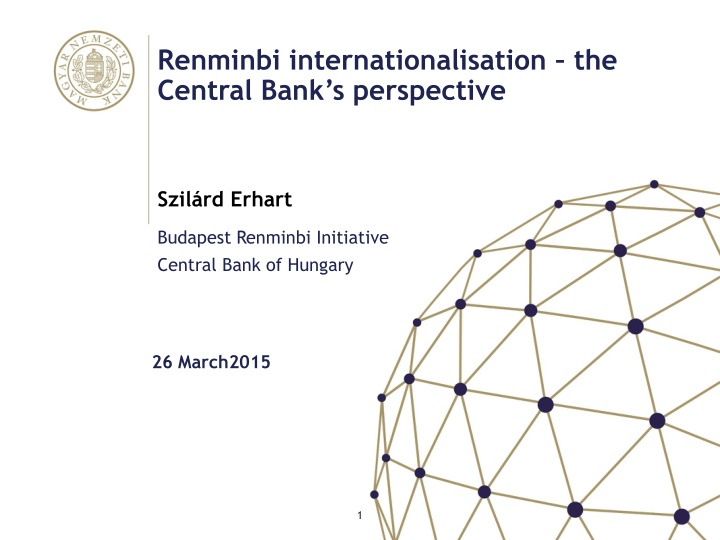
Central Bank's Perspective on Renminbi Internationalisation
This article discusses the Central Bank of Hungary's perspective on the internationalisation of the Renminbi (RMB), covering topics such as RMB's role as a trading currency, capital account liberalisation, and its potential to become a reserve currency. It explores the background, current status, and future projections of RMB internationalisation, along with its impact on global exports and FX market turnover.
Uploaded on | 1 Views
Download Presentation

Please find below an Image/Link to download the presentation.
The content on the website is provided AS IS for your information and personal use only. It may not be sold, licensed, or shared on other websites without obtaining consent from the author. If you encounter any issues during the download, it is possible that the publisher has removed the file from their server.
You are allowed to download the files provided on this website for personal or commercial use, subject to the condition that they are used lawfully. All files are the property of their respective owners.
The content on the website is provided AS IS for your information and personal use only. It may not be sold, licensed, or shared on other websites without obtaining consent from the author.
E N D
Presentation Transcript
Renminbi internationalisation the Central Bank s perspective Szil rd Erhart Budapest Renminbi Initiative Central Bank of Hungary 26 March2015 1
Agenda Quick wrap of RMB internationalisation Central banks responsibilities and the MNB s Renminbi Program 2 Magyar Nemzeti Bank
1. Background of RMB internationalisation crossing the river by feeling the stones Deng Xiaoping Magyar Nemzeti Bank 3
The RMB internationalisation story in short 1. PAST: Current account liberalisation implemented RMB is now a trading currency 2. PRESENT: Capital account liberalisation started RMB may become an investment currency (QFI, RQFI, ODI, QDII, etc) FUTURE: Exchange rate and interest rate liberalisation is on the way become a reserve currency You are here. 3. - RMB may Magyar Nemzeti Bank 4
Chinas share in global exports has jumped since its WTO membership in 2001 Share in global exports (%) 60 50 40 30 20 10 0 United States Europe China 1948 1953 1963 1973 1983 1993 2003 2012 Source: WTO http://www.wto.org/english/res_e/statis_e/its2013_e/section1_e/i05.xls Magyar Nemzeti Bank 5
RMBs weight in payments and FX-market turnover is still low, but increased fast recently Weight of selected currencies in payment and FX market turnover (2013) 50% 45% 40% 35% 30% 25% 20% 15% 10% 5% 0% ZAR MXN DKK HKD RUB TRY SEK GBP JPY THB NOK EUR SGD CNY USD AUD CHF CAD NZD Payment (SWIFT) FX market turnover (BIS) Magyar Nemzeti Bank Source: SWIFT, BIS 6
The RMBs payment weight in European renminbi centers grew to 20-40 percent Renminbi payments value weights (international flows sent to and received directly from China and Hong Kong) 100% 90% 80% 43 56 70% 60 64 74 77 60% 81 88 92 94 50% Others CNY 40% 30% 58 44 20% 40 36 26 23 10% 19 12 8 6 0% July 2013July 2014July 2013July 2014July 2013July 2014July 2013July 2014July 2013July 2014 United Kingdom France Germany Luxembourg Switzerland Magyar Nemzeti Bank Source: SWIFT 7
Hong Kong is the most important RMB center, however London and Luxembourg are coming up Portfolio investment Average daily trading volume of RMB foreign exchange (Apr 2013) RMB deposits (bn RMB, Dec 2014) Trade of goods with China (bn USD, 2013) Portfolio investments to China (End of 2012) Official clearing bank Number of listed bonds (Dec 2013) RQFII (bn RMB) ASIA Hong Kong Singapore Taiwan EUROPE Luxembourg United Kingdom France Germany TOTAL BUSINESS OUTLOOK (SWIFT) BOC ICBC BOC 945 254 268 401 76 197 270 50 100 98 74 13 288 50 na. 49.5 23.7 2.6 ICBC CBC BOC BOC 67 15 20 20 2 40 15 4 3 247 38 33 13 3 425 0.4 24.2 1.1 0.5 102 70 50 162 958 80 80 80 660 1589 good good outstanding outstanding Source: PWC, SWIFT, Central Banks Magyar Nemzeti Bank 8
Central banks are collaborating with market participants on the RMB internationalisation Renminbi initiatives in Europe Members from the public sector City Country Intitiative Members from the private sector Agricultural bank of China,Baker and Mckenzie,Bank of China,China Construction Bank,Citi,Commerzbank,Deutshe Bank, Deutshe Borse, DZ Bank,Frankfurt Main Finance,Gize,Helaba, HHSBC,ICBC, IHK, KFW,King and Wood,Messer,pwc, Simmons and Simmons, SWIFT, Volkswagen Agricultural Bank of China,Australia and New Zealand Banking Group Limited,Bank of China, Bank of Communications (UK), Barclays, China Construction Bank,Citi, Deutsche Bank, HSBC, ICBC,JP Morgan, Royal Bank of Scotland,Standard Chartered Bundesbank, essisches Ministerum f r Wirtschaft, Energie, Verkehr und landesentwicklung, RMB Initiative group Frankfurt Germany City of London, HM Treasury, Bank of England, Financial Services Authority City of London initative Luxemburg Center for International RMB Business in the Eurozone Paris Europlace - Your Hub to the Eurozone London United Kingdom Finance Ministry, Commission de Surveillance du Secteur Financier Bank of China, China Construction Bank, Clearstream, Luxembourg Stock Exchange, ICBC, Luxembourg Bankers' Association (ABBL), Luxembourg Fund Association (Alfi) Luxemburg Luxemburg Bank of China, Paris, BPCE Natixis,BNP Paribas, Cr dit Agricole, HSBC France, ICBC (Industrial and Commercial Bank of China), Paris, Soci t G n rale Banque de France, Tr sor Francais Central Bank of Hungary, Ministry of Finance, Government Debt Management Agency Paris France Budapest Renminbi Initiative Hungarian Banking Association, Hungarian Development Bank, Budapest Stock Exchange, Bank of China Hungary, Audi, Mercedes, ZTE, Huawei Budapest Hungary Magyar Nemzeti Bank 9
2. Central banks achievements, challenges and the MNB s Renminbi Program 1. Inter central bank swapline agreements 2. RMB instruments 3. Foreign reserve management 4. Financial stability and supervisory issues 5. Settlements and clearing Magyar Nemzeti Bank 10
1. The PBOCs network became the largest segment of the global inter central bank swapline network The international swap line network structure* The PBOC enlarged its network, while the ECB and FED did not FED (2009) 14 partners Network of the big 6 Chiang Mai initiative The main objectives of swap line agreements are to strengthen economic relations encourage bilateral trade and investment activity and maintain financial stability ECB (2010) BRICS (2014) PBOC (2014) 29 partners *The chart was prepared with Gephi network viwualisation software on the basis of information from Allen and Moessner (2010)1, Liao-McDowell (2013), PBoC and central Magyar Nemzeti Bank 11 banks.
The total valaue of PBOC swapline arrangements is over USD 400 bn value (RMB) 360 70 20 400 100 180 3.5 150 7 5 150 10 70 25 0.7 200 190 35 20 1.6 15 2 200 350 10 150 10 35 200 2725 value (USD) 57.6 11.2 3.2 64.0 16.0 28.8 0.6 24.0 1.1 0.8 24.0 1.6 11.2 4.0 0.1 32.0 30.4 5.6 3.2 0.3 2.4 0.3 32.0 56.0 1.6 24.0 1.6 5.6 32.0 436 No Partner country 1 South Korea 2 Argentina 3 Belarus 4 Hong Kong 5 Indonesia 6 Malaysia 7 Iceland 8 Singapore 9 Kazakhstan 10 Mongolia 11 Russia 12 Pakistan 13 Thailand 14 New Zealand 15 Uzbekistan 16 Australia 17 Brazil 18 U.A.E 19 Japan 20 Turkey 21 Ukraine 22 Albania 23 United Kingdom 24 Euro Area 25 Hungary 26 Switzerland 27 Sri Lanka 28 Qatar 29 Canada Total Announcement 2008 2009 2009 2009 2009 2009 2010 2010 2011 2011 2011 2011 2011 2011 2011 2012 2012 2012 2012 2012 2012 2013 2013 2013 2013 2014 2014 2014 2014 Extension 2011,2014 na na 2011 2013 2012 2013 2013 The Central Bank of Hungary followed the example of the ECB and BoE and joined the PBOC s swapline network in 2013. The PBOC carried out transactions amounting to RMB 511 billion (approx. USD 80 billion) in H1 2014. 2014 2014 Operational risk may occur as some central banks have not yet drawn renminbi funds at all, and all conditions of bilateral swapline transactions have not been finalised yet. Magyar Nemzeti Bank 12
2. RMB instruments of central banks Due to the limited convertibility in RMB offshore markets, central banks swapline network may serve financial stability purposes (liquidity backstop). Main characteristics of central banks RMB instruments Central banks Facility announced Goal of swapline Maturity Settlement Price BoE liqudity backstop RNBZ liqudity backstop RBA MAS liqudity backstop liqudity backstop SHIBOR + 25 bp O/N - minimum CNH HIBOR 1W - SHIBOR 1M - SHIBOR O/N 1W 1M t (O/N) t+1 (1W) t+1 (1M) X trade finance liqudity backstop X 3M t+1 SHIBOR HKMA ON, TN, 1W t (O/N), t+2 (TN,1W) according to market rates X BOK EKB trade finance liqudity backstop X 3M, 6M 1W SHIBOR t+4 SHIBOR + 100 bp 13 Magyar Nemzeti Bank
3. RMB foreign reserves ( ) central banks across the world have started to hold onshore Chinese renminbi (CNY) in their reserves portfolios, ( ) This is an issue that the Eurosystem will also have to further reflect on in the future. Beno t C ur , ECB Executive Board member 17 November 2014 Opportunities: Liquid market: onshore Chinese government bond market is the fifth- largest in the world yield: relatively high, and RMB appreciation magnified yields of unhedged positions in the past Diversification gains: by lowering market, credit and concentration risks Strong fundamentals: low debt ratio, high ratings Investor CBs: BOE, RBA, BDC, BON, BOK, etc Size of the RMB portfolio: 1-3 % of the total foreign reserves Quota: Central banks have been granted investment quotas since the first rounds of capital account liberalisation. Challenges: differences in legal norms, Implementation of investments (technical conditions, settlement, communication, onshore or offshore?) Transparency, follow-up and repatriation of investments 14
4. Financial stability and regulatory issues ANSWERS regulatory limits on the scope of banking services to protect tax-payers Monitoring of cross-border RMB activities Currency mismatch Capital flows Regulatory arbitrage Continous development of the regulatory framework Supervisory cooperation with Chinese authorities Establishment of information sharing practices (similarly to supervisory colleges) Revision of MoUs on supervisory issues Development of the institutional framework CHALLENGES BOE risks to financial stability: capital account liberalisation can also be accompanied by risks to domestic and global financial stability Hooley, J. (2014) MAS - liberalisation requires adequate sequencing: Risk of capital outflow if liberalisation of capital controls is prior to the liberalisation of interest rates interest rate liberalisation may add to the costs of banks, reduce profit rates IMF, Eichengreen (2014) further development of the institutional framework could be advantageous: establishment of deposit insurance and investment protection institutions, company information system and credit rating, independent central bank etc Currency mismatch risks (FX lending experience in CEE countries) FX reserve adequacy may worsen in non-eurozone countries FX- Liquidity Coverage Ratio may deteriorate in RMB hubs Regulatory arbitrage: Luxembourg used to be preferred to London due to Luxembourg s more favourable supervisory practice Magyar Nemzeti Bank 15
5. Clearing and settlement issues Details of Chinese clearing and settlement agreements PBOC typically concluded memorandums of understanding (MoU) on clearing and settlement with its swapline partner central banks. Official clearing bank Swapline agreement Official clearing banks: BoC Bank of China CCB China Construction Bank ICBC Industrial and Commercial Bank of China MoU on clearing arrangement clearing bank clearing bank announcement South Korea Hong Kong Singapore New Zealand Australia Frankfurt London Luxemburg Paris Budapest Switzerland Qatar Malaysia Thailand 2008 2009 2010 2011 2012 2013 2013 2013 2013 2013 2014 2014 2009 2011 2014.07.03 2009.03.19 2013.04.08 BoC BoC ICBC 2014.07.14 2007 2013.02.08 BoC BoC CCB ICBC BoC 2015.02.15 2014.06.19 2014.06.18 2014.09.23 2014.09.23 2014.03.28 2014.03.31 2014.06.28 2014.06.30 CIPS China International Payment System is expected to be launched in September 2015 to process cross-border RMB transactions 2015.01.27 2014.11.13 ICBC BoC ICBC 2014.11.14 2015.01.08 2015.01.08 Magyar Nemzeti Bank 16
The MNBs Renminbi Program Starting point: RMB swapline agreement (September 2013) Budapest Renminbi Initiative (from March 2015) FX reserve management Investigation whether a small portion of the foreign reserves could be invested in renminbi assets. Clearing and settlement (from February 2015) Planning of the renminbi clearing and settlement infrastructure Memorandum of Understanding. Supporting the appointment of the official renminbi clearing bank. RMB instruments (2015): Investigation whether renminbi liquidity instruments can/should be applied. Financial stability and supervisory issues (2015): Investigation of the risks related to the increasing renminbi market activity and monitoring of Chinese credit institutions, especially with regards to cross-border activity and to risks stemming from contagion and imbalances of the Chinese financial system. Cooperation with Chinese supervisory authorities and strengthening of the supervisory coordination and information sharing procedures. 17
Thank you for your attentiaon! Magyar Nemzeti Bank 18








